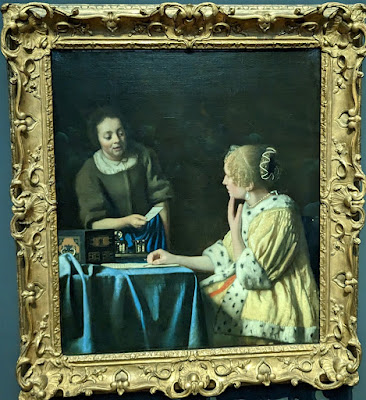We are not big Vermeer fans, but we have never knowingly missed a Vermeer painting, and perhaps one impetus for going to this show was to understand more fully what all the fuss is about. We read Tracy Chevalier's Girl with the Pearl Earring in our book club way back in our employment years, and then saw the movie--before ever seeing a Vermeer painting in person. We journeyed to San Francisco one year to see the Pearl Earring when the Mauritshuis was under renovation and its collection touring, and then to The Hague to see it and others when the museum was put back together again. And we have seen Tim's Vermeer, a fine movie/documentary indeed, which explores conjectures about Vermeer's technique.
But, really, why all the fuss? The guy's artistic output was miniscule, the paintings all quite small, his influence nil, the subjects of little interest (or beauty), the paintings as a whole, most of them genre or tronie paintings, when seen together, a bit monotonous. Almost nothing, apart from public records, is known of him. The camera obscura/camera lucida thing is intriguing, sort of, but then Leeuwinhoek was a friend and in fact the executor of Vermeer's will. We'd hardly be shocked to learn that Picasso used x-rays if we knew that Madame Curie was a close personal bud. Visual art has always been about technology, developments in materials, media, instruments, understanding of optics and optical processing, and so on. (OK, also beauty, feeling, conviction...). The most interesting bit, to me, is that Vermeer never hesitated using the most expensive pigments, even for under-coating. Ultramarine. So it is written. Possibly self-taught--there's no record of his being anyone's student or apprentice--but he certainly understood color.
The exhibition itself was very crowded, the lighting not wonderful. Not ideal for photography. Nor for lingering study. The interpretive signage was helpful but not much beyond the "this is a middle-class woman standing by a table, in front of a window [always on the left], reading a letter" variety. The good news is that the entire exhibition, including interpretation, is available on-line. English interpretation by Stephen Fry. It sold out many months ago, 250,000 tickets in the first 24 hours alone. Just go to https://www.rijksmuseum.nl/en/johannes-vermeer?ss=. It's actually quite good. I took pix of all the paintings, and more, but, in view of the virtual visit available, I won't post them all. The absence of several of Vermeer's most admired pieces, e.g., The Girl with the Pearl Earring, the most famous of all tronies, was conspicuous and disappointing. Of course, it's only 30 minutes away by train. Here is the Rijksmuseum's list of Vermeer paintings not in the exhibition, with some interesting explanations. And non-explanations.
 |
| Diana and Her Nymphs, 1655, Mauritshuis; brief mythological/ religious phase |
 |
| Christ in the House of Mary and Martha, 1654-1655, National Gallery, Scotland; "so there I was, with 5,000 hungry mouths to feed...no telling what they'd been promised..." |
 |
| The Procuress, 1655; Gemaldegalerie, Dresden, Germany; definitely not mythological/religious |
 |
| Girl Reading a Letter at an Open Window, 1657-1658; Gemaldegalerie, Dresden; finally, he has settled on the genre genre that he is known for; this is the one that was seen for 300 years as having a blank wall behind the girl; investigations in 1979 showed that someone had over-painted the portrait of Cupid; much more recently it has been shown that the over-painting could not have been done in Vermeer's lifetime...and so, in the restoration, the Dresden museum also restored Cupid and Vermeer's original intent; Vicki, our expert on the matter, felt the reappearance of Cupid was an improvement |
 |
| The Milkmaid, 1658-1659, Rijksmuseum; one has to wonder what's really on the wall behind her |
 |
| Crowded, for a ticketed, timed exhibition... |
 |
| Officer and Laughing Girl, 1657-58, Frick, USA; "so two Belgians walk into a bar, and..." |
 |
| Young Woman with a Lute, 1662-1664; Metropolitan Museum of Art, New York, USA; not his most attractive model |
 |
| Woman Writing a Letter, with Her Maid, 1670-1672, National Gallery, Ireland; or maybe just a grocery shopping list... |
 |
| The Lacemaker, 1666-1668; Louvre, France |
 |
| Girl with a Red Hat, 1664-1667, National Gallery, USA; definitely tronie phase (look it up) |
 |
| Mistress and Maid, 1664-1667, Frick, USA |
 |
| A Lady Writing, 1664-1667, National Gallery, USA; I think she's wearing a pearl earring too |
 |
| Woman in Blue Reading a Letter, 1662-1664, Rijksmuseum |
 |
| The Love Letter, 1669-1670, Rijksmuseum |
 |
| Young Woman Standing at a Virginal, 1670-1672, National Gallery, UK; Cupid is back |
 |
| The Glass of Wine, 1659-1661, State Museum, Berlin, Germany |
 |
| Girl Interrupted at Her Music, 1659-1661, Frick, USA |
 |
| The Geographer, 1669, Stadel Museum, Frankfurt am Main, Germany |
 |
| Woman with a Pearl Necklace, 1662-1664, State Museum of Berlin, Germany |
 |
| Woman Holding a Balance, 1662-1664, National Gallery, USA |
 |
| Helpful line-up of all Vermeer's known paintings |
 |
| Helpful life timeline |
 |
| Helpful list of cooperating museums, the USA prominently represented |



1 comment:
Loved your photos and commentaries. I had never thought about how similar his paintings were before. All the paintings on the wall behind the main subject...so very interesting! Yes, I wonder what is behind the white painted walls, too!
Post a Comment